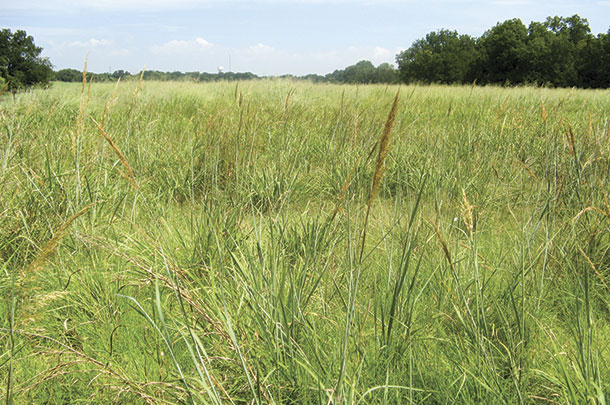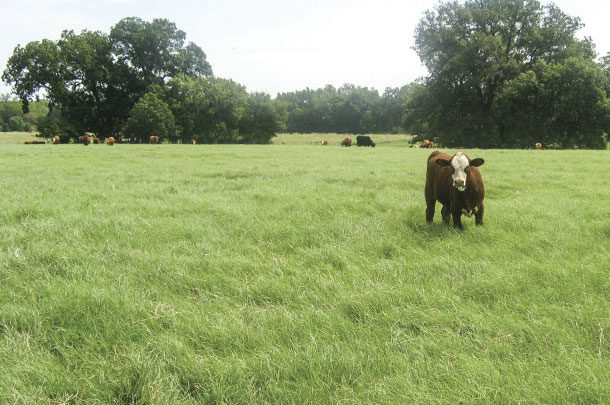Land managers who are successful forage growers have a better chance of making a profit on cattle than those that depend on purchased feed. Many current cow-calf operators consider themselves grass farmers who harvest their crops with cattle. They know it is hard to produce calves efficiently without ample nutritious forage for the cow herd.
To provide cattle with their required nutrients through grazing, an operator must understand the land, its history and capabilities. Good managers design grazing systems to fit available resources and ranch objectives. No single system is applicable for all ranches.
A good example of a grazing system designed to fit the ranch is utilized by Murray Randle, owner and operator of the 7R Ranch near Granbury, Texas. His ranch terrain varies from near flat areas of deep, dark loams and sand to rolling ridges of thin, gravely soils over hard layers of limestone. Many of the flatter areas were cotton fields in the 1940s.
“I decided that the most economical and quickest way to put the fields in forage production was to plant them with hybrid bermudagrass,” Randle says as he referred to soil and pasture maps of his ranch. “Either Coastal bermudagrass or Tifton 85 was planted in the old fields, leaving the untillable land in native grasses.”
Summer grazing
“Randle grazes his bermudagrass pastures during the growing season and native range during the winter months,” says Kent Ferguson, retired state range specialist from Natural Resources Conservation Service (NRCS) and now a private consultant. “Warm-season perennial grasses such as bermudagrass produce large amounts of high-quality forage that must be utilized during the summer months because they do not retain their grazing value during the rest of the year.”
“Nutritional value of bermudagrass and other warm-season perennial grasses is limited by their relatively high concentrations of fiber and lignin that reduce digestibility,” says Monte Rouquette, Ph.D., Texas A&M AgriLife Research.
“Tifton 85 has higher dry matter production and drought tolerance than other bermudagrasses. It has lower lignin concentration than Coastal bermudagrass and higher digestibility. Because of these characteristics, it provides increased animal performance over the other bermudagrasses.”
“A good fertilization program and careful attention to stage of maturity at harvest or grazing greatly enhances nutritive value of bermudagrass,” explains Vanessa Corriher Olson, Ph.D., Texas A&M AgriLife Extension Service. “Bermudagrass is highly responsive to nitrogen fertilization, but it also requires adequate amounts of phosphorus and potassium for good plant growth and persistence.”
“My fertilization program on hybrid bermudagrass is an application of 20-0-20 after each harvest,” says Randle. “The amount used per acre depends upon soil test results. One of the bermudagrass fields is dedicated to hay production. All of the hay is sold through contract except for a small percentage that is fed to heifers after weaning. Both bermuda and native grass pastures are rotational grazed.”
The bermudagrass is grazed by lactating cows that require from 8.7 to 10.5 percent crude protein in their diets. Their needs are more than amply met with the 12 to 16 percent crude protein in the bermudagrass.
Winter grazing
Due to deterioration from overgrazing by previous owners, Randle has reseeded some of the native range on the 7R Ranch. Using a sod seeder, he planted big bluestem, indiangrass, switchgrass and eastern gamagrass. Little bluestem was thriving and did not need replanting.
These five plants are tall prairie bunch grasses that grow as singular plants in clumps rather than forming sod. Crude protein content of eastern gamagrass can be as high as 17 percent, but the maximum is about 15 percent in the other four grasses. The higher levels of crude protein occur early in the growing season and decline to approximately 6 percent in late August, a level that is adequate for maintaining cattle bodyweight during the winter.
“Some of the identifying characteristics of big bluestem is its height of 3 to 6.5 feet and a representative seedhead that is shaped and dark-colored like a turkey foot,” explains Ferguson.
“Little bluestem ranges in height from 3 to 5 feet and has a white fuzzy seedhead. The two bluestems begin growth in late spring and provide fair to good forage while young. Forage quality is maintained through the growing by grazing. Tall plants with leafless, blue-tinted seed stalks often give the false impression of pasture nonuse. Examination at the ground surface, however, reveals that fine leaves at the base of the plants are providing quality grazing.”
Indiangrass occurs in bunches or as single stems mixed with the other grasses. It ranges in height from 3 to 6 feet and produces heavy golden seedheads. Indiangrass is very nutritious and readily consumed by cattle.
 Switchgrass grows from 20 inches to 8 feet tall and its leaves are red to purple at the base. The large seedhead is pyramid-shaped with purplish spikelets. Cattle eat switchgrass during the spring, but its palatability diminishes when seedheads appear.
Switchgrass grows from 20 inches to 8 feet tall and its leaves are red to purple at the base. The large seedhead is pyramid-shaped with purplish spikelets. Cattle eat switchgrass during the spring, but its palatability diminishes when seedheads appear.
Eastern gamagrass is more productive, palatable and nutritious than the other four grasses. It is a distant relative of corn and can reach a height of 8 feet.
“Available protein in the range pastures is increased by the presence of native cool-season plants such as Texas wintergrass, Canada and Virginia wild rye, wild barley and cool-season forbs (broad-leaf herbaceous plants),” says Ferguson. “Overall available protein in the pastures is about 8 percent.”
“Native range is grazed by dry, bred cows and their crude protein requirements are approximately 7 to 8 percent depending upon their stage of pregnancy,” says Randle.
“When they reach the third trimester of pregnancy, their crude protein requirements increase to near 9 percent. To meet these increased requirements, I begin feeding 4 pounds per animal of 38 percent crude protein cottonseed cubes 60 days prior to calving. My cattle maintain body condition scores of 5 to 6, the recommended condition for calving. Some of the bermudagrass pastures are overseeded with annual ryegrass and various clover species for winter grazing by the heifers.”
“Randle maintains a light stocking rate, which is one reason his cattle stay in good body condition,” adds Ferguson. “The practice also enables his pastures to withstand drought. During the recent three-year dry period, Randall sold more heifers than usual, but he was able to avoid selling his productive cows and decreasing herd genetics. Also, the animals stayed in good body condition during this period.”
In summary, Ferguson says, “A good grazing manager possesses a love of the land, learns the names of major plants on the property and understands how grass grows.” ![]()
PHOTO 1: Cattle graze summer pasture containing hybrid bermudagrass.
PHOTO 2: Native range in Texas is ready for winter grazing with indiangrass at the forefront. Photos by Robert Fears.
Robert Fears is a freelance writer based in Georgetown, Texas. Email Robert Fears.










